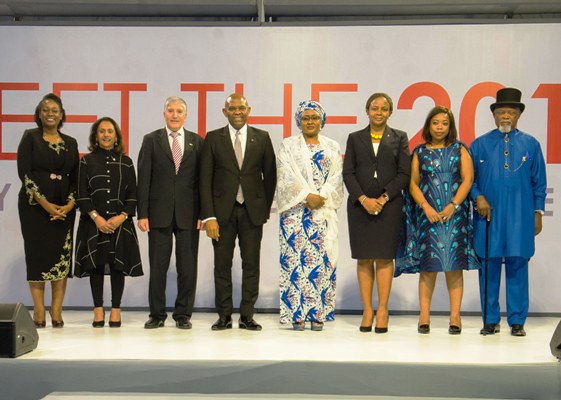A photo montage of bank CEOs
Banks are struggling to recover money advanced to customers in form of loans as the economy bites hard.
According to the exclusive analysis by Business Focus of the audited financial statements of the 25 banks for the year ending 31st December 2023, Non-Performing Loans (NPLs) stood at a whopping Shs1.09 trillion.
A Non-Performing Loan (NPL) is a loan in which the borrower is in default and hasn’t made any scheduled payments of principal or interest for a certain period of time. In banking, commercial loans are considered nonperforming if the borrower is 90 days past due.
NPLs are subject to late repayment or are unlikely to be repaid by the borrower.
According to the Bank of Uganda, NPLs are considered high when the NPL ratio exceeds 5%. NPL ratio is the ratio of the amount of NPLs in a bank’s loan portfolio to the total amount of outstanding loans the bank holds.
The analyzed financial statements for various banks show that total industry NPL ratio stands at 5.37% as of 31st December 2023. However, this analysis doesn’t capture Stanbic bank but its NPLs have historically been low.
Banks With highest NPLs
Guaranty Trust Bank has the highest NPLs in the market with NPL ratio of 26.28%. This is after its NPLs increased to Shs14.8bn in 2023, up from Shs6.92bn in 2022. This is against loans worth Shs56.3bn advanced to customers in 2023. Headed by Oluwolse Shodiyan as Managing Director, Guaranty Trust Bank’s bad debts written off also increased to Shs1.84bn in 2023 from Shs1.35bn in 2022.
Guaranty Trust Bank has since failed to meet the new Bank of Uganda minimum capital requirements of Shs150bn and will downgrade from a Tier I Commercial Bank License to a Tier II Credit Institution License effective July 1, 2024.
Equity Bank has the second highest NPLs. This is after its NPLs increased to Shs363.97bn in 2023, up from Shs277.75bn in 2023. This is against loans worth Shs1.6 trillion advanced to customers in 2023. This gives the lender the NPL ratio of 22.74%. Equity’s bad debts written off increased to Shs60.75bn in 2023 from Shs34.79bn in 2022. This explains why Equity Bank Uganda that is headed by Anthony Kituuka as Managing Director, made a shock loss of Shs18.77bn in 2023.
Equity is followed by Cairo Bank Uganda with NPL ratio of 19.4%. Headed by Sylvia Jagwe Owachi as Ag. Managing Director, Cairo Bank’s NPLs increased to Shs34.29bn in 2023, up from Shs21.06bn recorded a year earlier. This is against Shs176.7bn in loans advanced to customers in 2023. The bank’s bad debts written off increased to Shs10.85bn in 2023 from Shs3.8bn recorded a year earlier.
I&M Bank’s NPLs also remain high with its NPL ratio standing at 13.7%. Headed by Robin Baistow, I&M’s NPLs increased to Shs41.4bn in 2023, up from Shs30.49bn in 2022. This is against Shs300.9bn in loans advanced to customers in the year under review. However, its bad loans written off reduced to Shs2.19bn in 2023 from Shs7.72bn recorded in 2022.
Its followed by Tropical Bank with NPL ratio of 12.56%. Headed by Abdulaziz Mohamed A. Mansur, Topical Bank’s NPLs reduced to Shs13.96bn in 2023, down from Shs26.61bn in 2022. This is against Shs111.1bn in loans advanced to customers. Its bad debts written off increased to Shs7.55bn in 2023 from Shs5.98bn in 2022.
Absa Bank Uganda is the 6th bank with highest NPLs in Uganda. Its NPLs reduced to Shs175.2bn in 2023, down from Shs194.84bn in 2022 while its loans advanced to customers stood at Shs1.76 trillion in 2023. This gives the bank the NPL ratio of 9.95%.
Absa’s bad debts written off reduced to Shs11.5bn in 2023 from Shs14.9bn recorded a year earlier.
Check for more details about banks with highest and lowest NPLs in Uganda
NPLS-RatioIt’s followed by Dfcu Bank whose NPLs increased slightly to Shs108.17bn in 2023, up from Shs107.67bn in 2022. This is against Shs1.12 trillion in loans advanced to customers. This means the bank’s NPL ratio is 9.65%. Its NPL ratio reduced to Shs115.2bn in 2023 from Shs221.14bn in 2022.
In 8th position is Exim Bank whose NPL ratio is 7.94%. Its NPLs reduced to Shs14.7bn in 2023, down from Shs25.95bn recorded a year earlier. This is against Shs185.1bn in loans advanced to customers in 2023.
It’s followed by NCBA in 9th position. This is after its NPLs reduced to Shs18.01bn in 2023, up from Shs32.14bn recorded a year earlier. This is against Shs252.94bn in loans advanced to customers in 2023. This gives the bank the NPL ratio of 7.12%.
Housing Finance Bank is the 10th bank with highest NPLs in Uganda with NPL ratio of 5.75%.
Its NPLs increased to Shs57.3bn in 2023, up from Shs35.78bn in 2022. This is against Shs995.7bn in loans advanced to customers in 2023.
It’s followed by KCB Bank whose NPL ratio is 5.37%. This is after its NPLs increased to Shs40.96bn in 2023, up from Shs21.72bn in 2022. This is against Shs762.46bn in loans advanced to customers.
Opportunity Bank’s NPL ratio is 5.1%. This is after its NPLs reduced to Shs7.2bn in 2023, down from Shs13.14bn in 2022. Its loans advanced to customers in 2023 stood at Shs140.9bn.
From this analysis, 12 banks have NPL ratio above 5%.
Banks with low NPLs
Banks whose NPL ratio is below 5% include ABC (4.91%),PostBank (4.4%), Finance Trust Bank (4.25%), Standard Chartered Bank (2.99%), Bank of Africa (2.95%), Centenary Bank (2.8%), DTB Uganda (1.98%), Ecobank (1.58%), Bank of India (1.19%),UBA Uganda (0.50%) and Bank of Baroda (0.03%).
Check for more details about banks with highest NPLs in Uganda
NPLS1We’ll continue giving you unmatched analysis about the performance of banks in 2023 and beyond. For tips, opinions and advertising, Tel: 0775170346/0703828741/staddewo@gmail.com. Follow us on Twitter: @TaddewoS @BusinessFocusug






